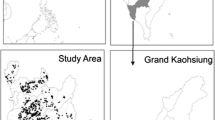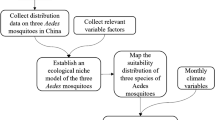Abstract
The ever-increasing emergence of Aedes albopictus as one of the most significant vectors of arboviruses like Zika, chikungunya, and dengue requires deeper studies in new areas using environmental factors. Almost 2 billion people in tropical and subtropical zones are exposed to the vector. Because of the vector’s tendency to reproduce in a variety of habitats, including urban, suburban, and rural areas, the species is spreading rapidly wherever a set of climatic factors is available. Iran as a country of diverse climates and biomes with more than 80 million population is highly prone to the disease. Hence, this study aims to monitor the risk probability of the mosquito’s presence according to the environmental parameters in Iran. In this research, we classified each parameter based on the appropriate conditions for the breeding and activity of the vector. To calculate the weight of each parameter, we applied analytical hierarchy process (AHP) as an expert-based decision-making method and risk map generated using spatial analysis. Finally, to classify the values of the risk map and finding the most important risk areas, we performed a grouping analysis. The result showed that 5 coastal counties in Guilan province in the north and 6 counties in Khuzestan province in the southwest of Iran were ranked first and second riskiest places, respectively. Due to the semi-tropical climate of the coastal areas, they record a suitable pattern of contributing parameters for the presence of the vector. These findings help for the public health policymakers to control the invasion of Aedes albopictus to estimate the related disease occurrence.






Similar content being viewed by others
References
Abdul-Ghani R et al (2019) Impact of population displacement and forced movements on the transmission and outbreaks of Aedes-borne viral diseases: dengue as a model. Acta Trop 197:105066
Ahmadkhani M, Alesheikh AA (2017) Space-time analysis of human brucellosis considering environmental factors in Iran. Asian Pacific J Trop Dis 7:257–265
Ahmadkhani M, Alesheikh AA, Khakifirouz S, Salehi-Vaziri M (2018) Space-time epidemiology of Crimean-Congo hemorrhagic fever (CCHF) in Iran. Ticks Tick Borne Dis 9:207–216
Ashby J, Moreno-Madriñán MJ, Yiannoutsos CT, Stanforth A (2017) Niche modeling of dengue fever using remotely sensed environmental factors and boosted regression trees. Remote Sens 9:328
Benedict MQ, Levine RS, Hawley WA, Lounibos LP (2007) Spread of the tiger: global risk of invasion by the mosquito Aedes albopictus. Vector Borne Zoonotic Dis 7:76–85
Clements AN (1999) The biology of mosquitoes, Volume 2: sensory reception and behaviour. CABI publishing, Wallingford
Dale P, Knight J (2008) Wetlands and mosquitoes: a review. Wetlands Ecol Manage 16:255–276
Dhimal M, Gautam I, Joshi HD, O’Hara RB, Ahrens B, Kuch U (2015) Risk factors for the presence of chikungunya and dengue vectors (Aedes aegypti and Aedes albopictus), their altitudinal distribution and climatic determinants of their abundance in central. Nepal PLoS Negl Trop Dis 9:e0003545
Ding F, Fu J, Jiang D, Hao M, Lin G (2018) Mapping the spatial distribution of Aedes aegypti and Aedes albopictus. Acta Trop 178:155–162
Doosti S et al (2016) Mosquito surveillance and the first record of the invasive mosquito species Aedes (Stegomyia) albopictus (Skuse)(Diptera: Culicidae) in southern Iran. Iran J Public Health 45:1064
Eritja R, Escosa R, Lucientes J, Marques E, Roiz D, Ruiz S (2005) Worldwide invasion of vector mosquitoes: present European distribution and challenges for Spain. Biological invasions 7:87–97
Hawley WA (1988) The biology of Aedes albopictus. J Am Mosq Control Assoc Suppl 1:1–39
Kobayashi M, Nihei N, Kurihara T (2002) Analysis of northern distribution of Aedes albopictus (Diptera: Culicidae) in Japan by geographical information system. J Med Entomol 39:4–11
Kollars TM Jr (2018) Potential for the invasive species Aedes albopictus and arboviral transmission through the Chabahar port in Iran. Iran J Med Sci 43:393
Kraemer MU et al (2015) The global distribution of the arbovirus vectors Aedes aegypti and Ae. albopictus. Elife 4:e08347
Leisnham PT, Juliano SA (2012) Impacts of climate, land use, and biological invasion on the ecology of immature Aedes mosquitoes: implications for La Crosse emergence. Ecohealth 9:217–228
Leta S, Beyene TJ, De Clercq EM, Amenu K, Kraemer MU, Revie CW (2018) Global risk mapping for major diseases transmitted by Aedes aegypti and Aedes albopictus. Int J Infect Dis 67:25–35
Lowe S, Browne M, Boudjelas S, De Poorter M (2000) 100 of the world's worst invasive alien species: a selection from the global invasive species database vol 12. Invasive Species Specialist Group Auckland,
Lutz N (2002) North carolina summer pest the asian tiger mosquito aedes albopictus. http://ecoaccess.org/info/wildlife/pubs/asiantigermosquitoes.html, [Online; accessed 25 May 2018]
Medlock JM, Avenell D, Barrass I, Leach S (2006) Analysis of the potential for survival and seasonal activity of Aedes albopictus (Diptera: Culicidae) in the United Kingdom. J Vector Ecol 31:292–304
Nejati J et al (2017) Potential risk areas of Aedes albopictus in south-eastern Iran: a vector of dengue fever, zika, and chikungunya. Front Microbiol 8:1660
Neteler M, Roiz D, Rocchini D, Castellani C, Rizzoli A (2011) Terra and Aqua satellites track tiger mosquito invasion: modelling the potential distribution of Aedes albopictus in north-eastern Italy. Int J Health Geogr 10:1–14
Nihei N, Komagata O, Mochizuki K-i, Kobayashi M (2014) Geospatial analysis of invasion of the Asian tiger mosquito Aedes albopictus: competition with Aedes japonicus japonicus in its northern limit area in Japan. Geospat Health 8:417–427
Pakzad R et al (2018) Spatiotemporal analysis of brucellosis incidence in Iran from 2011 to 2014 using GIS. Int J Infect Dis 67:129–136
Rochlin I, Ninivaggi DV, Hutchinson ML, Farajollahi A (2013) Climate change and range expansion of the Asian tiger mosquito (Aedes albopictus) in Northeastern USA: implications for public health practitioners. PloS one 8:e60874
Roiz D, Rosa R, Arnoldi D, Rizzoli A (2010) Effects of temperature and rainfall on the activity and dynamics of host-seeking Aedes albopictus females in northern Italy. Vector-Borne Zoonotic Dis 10:811–816
Saaty TL, Tran LT (2007) On the invalidity of fuzzifying numerical judgments in the Analytic Hierarchy Process. Math Comput Model 46:962–975
Sallam MF, Fizer C, Pilant AN, Whung P-Y (2017) Systematic review: land cover, meteorological, and socioeconomic determinants of Aedes mosquito habitat for risk mapping. Int J Environ Res Public health 14:1230
Seyedalizadeh N, Alesheikh AA, Ahmadkhani M (2019) Spatio-statistical modeling of human brucellosis using environmental parameters: a case study of Northern Iran. Int Arch Photogramm Remote Sens Spat Inf Sci 42:969–973
Shragai T, Tesla B, Murdock C, Harrington LC (2017) Zika and chikungunya: mosquito-borne viruses in a changing world: global change and vectors of chikungunya and Zika. Ann N Y Acad Sci 1399:61–77
Valerio L et al (2010) Host-feeding patterns of Aedes albopictus (Diptera: Culicidae) in urban and rural contexts within Rome province, Italy. Vector-Borne and Zoonotic Dis 10:291–294
Waldock J, Chandra NL, Lelieveld J, Proestos Y, Michael E, Christophides G, Parham PE (2013) The role of environmental variables on Aedes albopictus biology and chikungunya epidemiology. Pathog Global Health 107:224–241
Acknowledgement
We would like to express our gratitude to Dr. Mostafa Salehi-Vaziri, the head of the department of Arboviruses and Viral Hemorrhagic Fevers of Pasteur Institute of Iran, for his valuable comments on an earlier version of the manuscript.
Author information
Authors and Affiliations
Corresponding author
Ethics declarations
Conflict of interest
The authors declare no competing interests.
Rights and permissions
About this article
Cite this article
Shirzad, R., Alesheikh, A.A., Ahmadkhani, M. et al. Aedes albopictus: a spatial risk mapping of the mosquito using geographic information system in Iran. Appl Geomat 13, 691–700 (2021). https://doi.org/10.1007/s12518-021-00375-2
Received:
Accepted:
Published:
Issue Date:
DOI: https://doi.org/10.1007/s12518-021-00375-2




